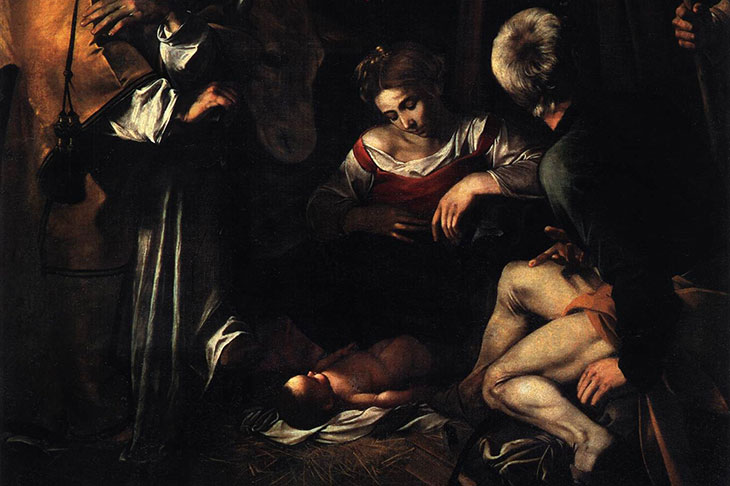Recent reports emanating from the Roman Anti-Mafia Commission’s office and the publication of a book by Sicilian investigative journalist, Riccardo Lo Verso (La Tela dei Boss) have reignited a longstanding debate about the possible whereabouts of Caravaggio’s Nativity with St Francis and St Lawrence, cut from its frame and stolen from the Oratory of San Lorenzo in Palermo on the night of 17/18 October 1969. As reported in The Guardian on 1 June, but prior to that in several Italian journals, information garnered from a former Mafia mobster suggests that the picture may be intact in Switzerland – a favourite destination for illicitly exported, let alone stolen, Italian Old Master paintings. If true, this would overturn various earlier rumours such as the one that it had been devoured by rats when stored in a barn or, more recently, and counter-intuitively, that it had been cut into pieces to be ‘more easily’ disposed of, again to Swiss private collectors. However appealing the prospect of its recovery might be to Italian, and especially Palermitan, authorities, who are understandably keen to reinstate it over the High Altar of the Oratory in place of the skilful reproduction of it produced by Factum Arte in 2016, one would do well to treat such testimonies with caution.
Nativity with St Francis and St Lawrence (1609), Caravaggio. Oratorio di San Lorenzo, Palermo

It is alleged that the picture was passed between various high-ranking Mafia families even if originally stolen by amateur local thieves, and it is possible that the earlier stories about its destruction might have been cover for its eventual successful sale to a Swiss-based collector, of which there are many. The inability to dispose of such a notorious piece of real estate may also account for the lengthy dormancy of any tangible evidence. Nevertheless, the potential for unreliability and subterfuge in such shifting testimonies is great: might not a former mobster invent such a story to ingratiate himself with the authorities?
A parallel tale of Caravaggio theft (and in that case also recovery), doubtless inspired by the notorious Palermo episode, occurred in Malta on New Year’s Eve, 1984, when Caravaggio’s St Jerome Writing was cut from its frame, with some damage, in St John’s Co-Cathedral in Valletta by Maltese criminals. The picture was recovered in a police sting after two years, largely due to the clandestine negotiations carried out by Fr Marius J. Zerafa, director of the National Museum of Fine Arts, who was initially worried about possible police complicity, just as long-serving Italian prime minister Giulio Andreotti was rumoured by some to be implicated in the Palermo heist. In such a climate of murky undercurrents it is almost impossible to separate fact from fantasy or invention. And how straightforward will it be for Italian investigators to breech the adamantine privacy of Swiss bank vaults?
St Jerome Writing (1607–08), Caravaggio. St John’s Co-Cathedral, Valletta, Malta

However, another mystery surrounding the Palermo Nativity is also in need of resolution: its date. Until very recently it was assumed to have been painted by Caravaggio in situ in 1609 on his rapid tour around Sicily, as strongly implied by his 17th-century biographers, Giovanni Baglione and G.P. Bellori, who record that he made pictures (unspecified) in Palermo after leaving Messina. Nevertheless, it was a worthy point of note amongst scholars, that its more finished handling than in Caravaggio’s three preceding Sicilian altarpieces (The Burial of St Lucy in Syracuse and the Adoration of the Shepherds and Raising of Lazarus in Messina, all mentioned in the 17th-century sources), arguably had more in common with the great church paintings of Caravaggio’s Roman maturity, such as The Martyrdom of St Matthew of 1599–1600 in the Contarelli Chapel of San Luigi dei Francesi. And now a groundswell of opinion amongst scholars (e.g. Claudio Strinati and Michele Cuppone) is seeking to claim that the picture was indeed done in Rome in 1600 and sent to the Oratory of San Lorenzo.
The link here is of a, once again unspecified, picture ‘with figures’, commissioned from Caravaggio in Rome by the Sienese merchant, Fabio Nuti, on 5 April 1600, with the size given as 12 Roman palmi high by 7 or 8 wide. The height would make it almost exactly right for the Sicilian painting, though neither of the width sizes, possibly given as alternatives in recognition of the possible need to adjust the proportions to an ongoing architectural refurbishment in the Oratory, are quite right. However, more recent researches have confirmed that Nuti made financial payments to Palermo around this time, so the question is certainly worthy of further investigation.
I am one of relatively few art historians to have seen the actual Nativity, in the summer of 1967, on a camping expedition from Oxford to Sicily with my brother to view Siculo-Norman architecture! But while I have only vague memories of this encounter, I am not as strongly attached to the new theory of a Roman origin as some. The proportion of the figures in relation to the space seems halfway between the Roman altarpieces and the Sicilian ones, while its mood and spirit of Franciscan piety are arguably more Sicilian. Equally, the treatment of the face of the old shepherd leaning on his crook at the right of the picture seems to have elements in common with, for example, the way in which Caravaggio constructed a face in the figure of St Anne in the late Roman altarpiece, Madonna of the Serpent (1606). One might also bear in mind that an 18th-century Sicilian biographer of Caravaggio, Francesco Susinno, drew attention to the variety of his styles.
John Gash is Senior Lecturer in History of Art at Aberdeen University.



